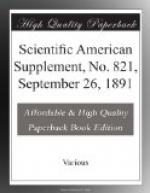of the tar paper roof by a spark or flame from the
outside was considered, and, second, it was tested
in how far it would resist a fire in the interior
of the building. In the former case, it was ascertained
that a bright, intense fire could be kept burning
upon the roof for some time, without igniting the woodwork
of the roof, but heat from above caused some of the
more volatile constituents of the tar to be expelled,
whereby small flames appeared upon the surface within
the limits of the fire; the roofing paper was not
completely destroyed. There always remained a
cohesive substance, although it was charred and friable,
which by reason of its bad conductivity of heat protected
the roof boarding to such an extent that it was “browned”
only by the developed tar vapors. A fire was
next started within a building covered with a tar paper
roof; the flame touched the roof boarding, which partly
commenced to char and smoulder, but the bright burning
of the wood was prevented by the air-tight condition
of the roof; the fire gases could not escape from
the building. The smoke collecting under the roof
prevented the entrance of fresh air, in consequence
of which the want of oxygen smothered the fire.
The roofing paper remained unchanged. By making
openings in the sides of the building so that the fire
gases could escape, the wood part of the roof was
consumed, but the roofing paper itself was only charred
and did not burn. After removing the fire in
contact with the paper, this ceased burning at once
and evinced no disposition whatever to spread.
In large conflagrations, also, the tar paper roofs
behaved in identically a similar manner. Many
instances have occurred where the tar paper roof prevented
the fire from spreading inside the building, and developing
with sufficient intensity to work injury.
As it is of interest to the roofer to know the manner
of making the material he uses, we give in the following
a short description of the manufacture of roofing
paper. At first, when square sheets were used
exclusively, the raw paper consisted of ordinary dipped
or formed sheets. The materials used in its manufacture
were common woolen rags and other material. In
order to prepare the pulp from the rags it is necessary
to cut them so small that the fabric is entirely dissolved
and converted into short fibers. The rags are
for this purpose first cut into pieces, which are
again reduced by special machines. The rags are
cut in a rag cutting machine, which was formerly constructed
similar to a feed cutter; later on, more complicated
machines of various constructions were employed.
It is not our task to describe the various kinds,
but we remain content with the general remark that
they are all based on the principles of causing revolving
knives to operate upon the rags. The careful
cleansing of the cut rags, necessary for the manufacture
of paper, is not required for roofing paper.
It is sufficient to rinse away the sand and other solid
extraneous matter. The further reduction of the
cut rags was formerly performed in a stamp mill, which
is no longer employed, the pulp mill or rag engine
being universally used.




